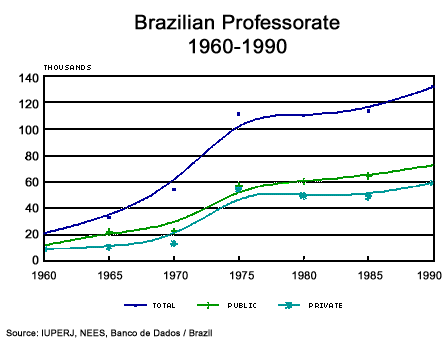Simon Schwartzman and Elizabeth Balbachevsky
Universidade de São Paulo| Table 1. Number of institutions, enrollment, number of teachers, full-time teachers and teachers with graduate degrees, by region and legal status of institutions (educational census data) | |||||
| number of institutions | % of total enrollment | % of teachers | % of full time teachers | % with a master's or a doctor's degree | |
| Region: | |||||
| North | 3.0 | 3.3 | 3.1 | 4.8 | 2.2 |
| Northeast | 11,2 | 15.8 | 16.7 | 22.0 | 15.5 |
| Southwest | 63.2 | 56,3 | 55.2 | 46.6 | 61.4 |
| South | 14.7 | 18,4 | 18.8 | 18.8 | 15.7 |
| Center West | 7,5 | 6,3 | 7.9 | 7.9 | 5.1 |
| Total | 100% | 100% | 100% | 100% | 100% |
| Legal Status | |||||
| Federal | 6.3 | 20.5 | 32.6 | 60.3 | 46.6 |
| State | 9.2 | 12.9 | 17.9 | 26.0 | 25.4 |
| Municipal | 9.4 | 5.3 | 3.7 | 2.0 | 1.4 |
| Private | 75.1 | 61.3 | 45.8 | 11.7 | 26.2 |
| Total | 100% | 100% | 100% | 100% | 100% |
| Total number | 893 | 1,565,056 | 133,135 | 57,728 | 46,758 |
| Source: data from the Ministério da Educação, Serviço de Estatística da Educação e Cultura, 1989. | |||||
